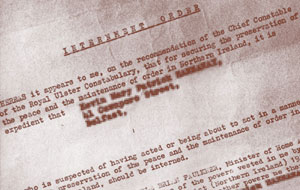9 August 2007 Edition
36th Anniversary of Internment

Blunt weapon of internment fails to crush nationalist resistance
BY ARAN FOLEY
In August 1971 the unionist regime at Stormont, under prime minister Brian Faulkner and supported by Edward Heath’s Tory government in London, introduced internment without trial in the North of Ireland. More than 340 men were taken to prison camps in the initial swoop.
‘Operation Demetrius’ was the codename the British Army had assigned to the introduction of internment. It was not the first time that internment had been used in the Six Counties. It had been employed in every decade since partition having first being placed on the statute books by Sir Richard Dawson Bates just after the partition of Ireland in 1922.
Internment – the imprisonment of people without charge or trial – was seen as an important weapon against any widespread political opposition to the sectarian, undemocratic nature of the one-party Orange state that existed in the Six Counties.
On various occasions since the 1930’s collaborationist administrations in the 26 Counties had felt confident enough to introduce internment of republicans in the South also. Not so this time – the violent suppression of peaceful civil rights demonstrators and significant public support for republican resistance North and South made that impossible.
In terms of defeating the IRA resistance, internment was a spectacular failure. Four hundred-and-fifty names had been supplied by the RUC of which 342 were detained. RUC intelligence was outdated and most IRA Volunteers had been forewarned and told to stay away from home.
Within 48 hours, 116 of those arrested were released. The remainder were detained at Belfast’s Crumlin Road Prison and on the prison ship The Maidstone in Belfast Lough.
It was noted that not a single loyalist was picked up during the initial internment swoops.
The hooded men
Of the hundreds detained, most were physically abused, but 13 were selected for special treatment. These had been secretly moved from the internment clearing centers to an unknown destination and held for seven days. They had hoods on their heads throughout, had no idea where they were and were kept completely isolated. The British deceived some detainees into believing that they were to be thrown from high flying helicopters. In reality the blindfolded detainees were thrown from a helicopter that hovered approximately four feet above the ground. All were severely beaten, forced to stand spread-eagled against walls until they collapsed, given hardly any food and subjected to `white noise’, which prevented them from sleeping. All the while they were constantly interrogated. This was a new technique, termed sensory deprivation, and designed to disorientate the mind and facilitate ‘in-depth interrogation’. The order for the removal of the men had been personally signed by Brian Faulkner.
Resistance
The nationalist people went into open rebellion in reaction to internment, with mass mobilisation and increased IRA attacks. A ‘rents and rates strike’ was introduced in protest against internment and within weeks was supported by 26,000 households. A day of action on 16 August saw 8,000 Derry workers on strike. The next day 30 prominent Derry nationalists withdrew from public bodies. Three days later 130 local councillors across the Ñorth withdrew from local councils.
In Derry City barricades were again erected around Free Derry and for the next 11 months these areas effectively seceded from British control. Protests, street demonstrations and riots were common as the entire community sought to demonstrate its opposition to internment.
Brutal reaction
In Belfast there was also resistance and brutal British reaction. In the two days after internment, eight people from the Greater Ballymurphy area were shot dead by the British Army, backing up loyalist mobs attacking Springfield Park. Among the dead was Catholic priest, Fr Hugh Mullan, shot through the heart as he went to give the Last Rites to a young man wounded by British Army gunfire.
As trouble erupted in Ardoyne, loyalists moved out of the area and torched their homes as they went so that Catholics couldn’t be housed in them. Three people from the area – IRA Volunteer Paddy McAdorey, 16-year-old Leo McGuigan and a Protestant woman, Sarah Worthington, were shot dead by the British Army in the hours after the introduction of internment.
IRA unaffected
The IRA held a press conference in Belfast on the 13 August at which Joe Cahill, the Officer Commanding the IRA in Belfast, said that internment had had no noticeable effect on IRA structures and that the IRA campaign would continue.
In the following months a number of rallies and marches were planned. On Christmas Day 1971, 4,000 protestors attempted to march from Belfast to Long Kesh. The march was blocked before reaching its destination on the M1 motorway and dispersed.
On the 22 January another protest march took place at Magilligan Strand, not far from Derry City. This protest was blocked by the British Army and dispersed with violence, in which members of the British Army’s Parachute Regiment were prominent. The following anti-internment rally was planned for Derry, on Sunday 30 January 1972 – a day that would go down in history for its infamy.
Internment was finally abandoned 5 December, 1975. Almost 2,000 nationalists had been detained during that time. The total number from the unionist community detained was just 107.
Internment without trial was imposed on 9 August 1971, 36 years ago next week.


